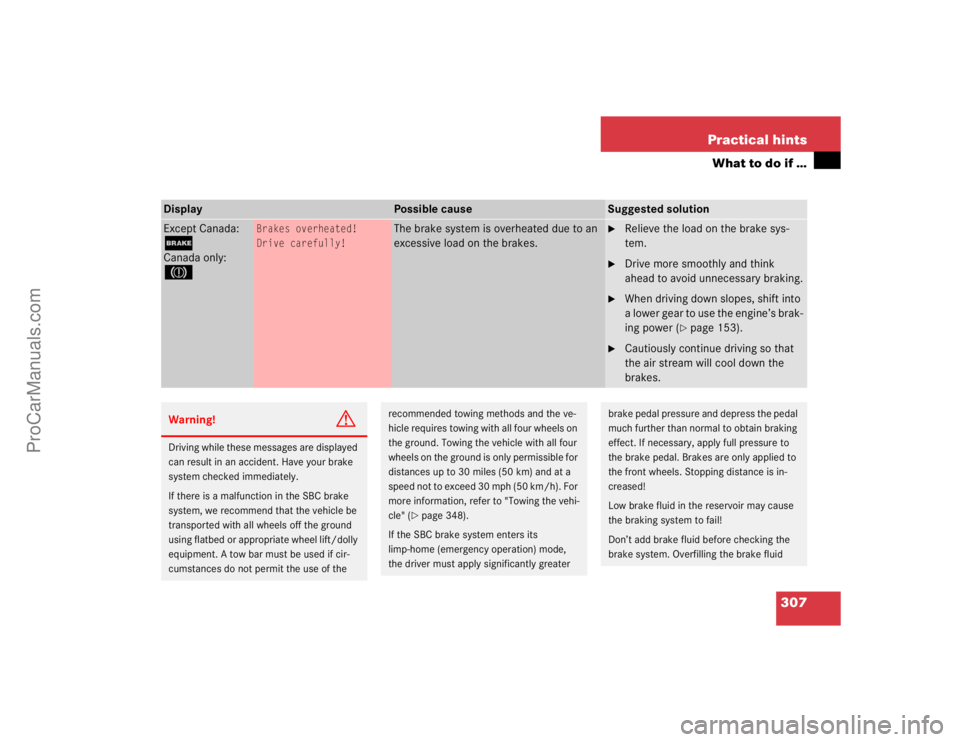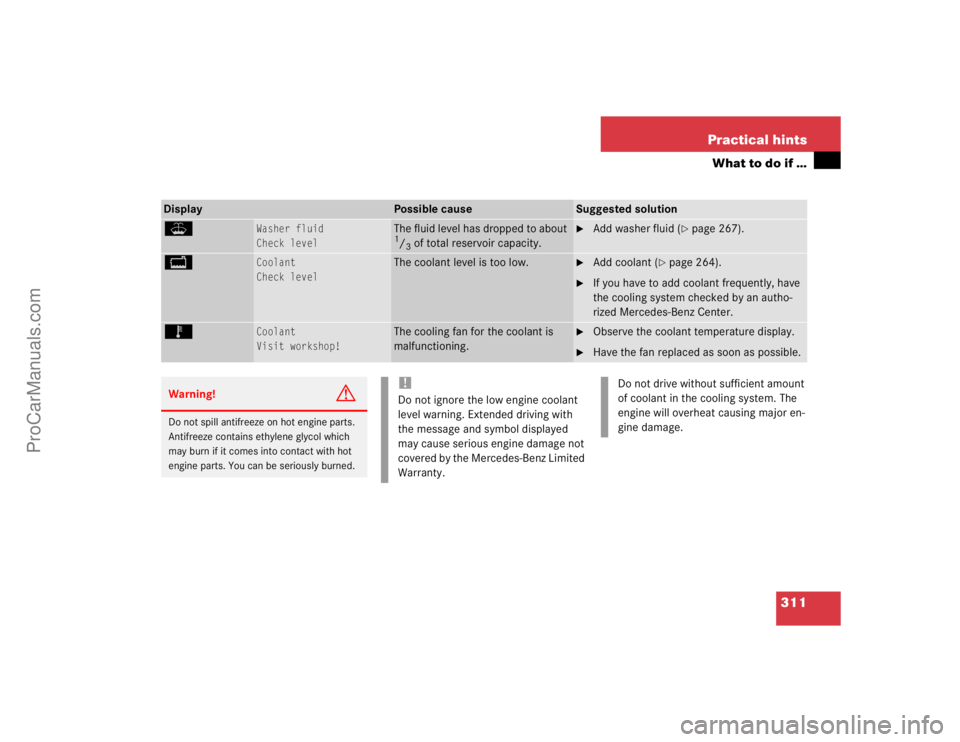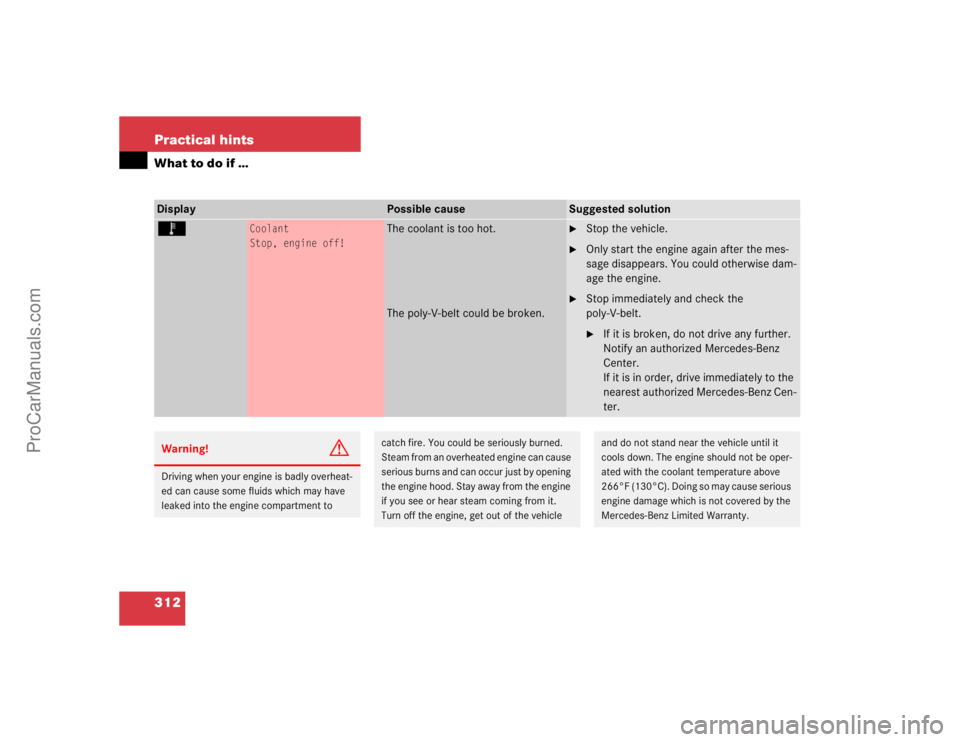Page 307 of 399

307 Practical hints
What to do if …
Except Canada:;Canada only:3
Brakes overheated!
Drive carefully!
The brake system is overheated due to an
excessive load on the brakes.
�
Relieve the load on the brake sys-
tem.
�
Drive more smoothly and think
ahead to avoid unnecessary braking.
�
When driving down slopes, shift into
a lower gear to use the engine’s brak-
ing power (
�page 153).
�
Cautiously continue driving so that
the air stream will cool down the
brakes.
Display
Possible cause
Suggested solution
Warning!
G
Driving while these messages are displayed
can result in an accident. Have your brake
system checked immediately.
If there is a malfunction in the SBC brake
system, we recommend that the vehicle be
transported with all wheels off the ground
using flatbed or appropriate wheel lift/dolly
equipment. A tow bar must be used if cir-
cumstances do not permit the use of the
recommended towing methods and the ve-
hicle requires towing with all four wheels on
the ground. Towing the vehicle with all four
wheels on the ground is only permissible for
distances up to 30 miles (50 km) and at a
speed not to exceed 30 mph (50 km/h). For
more information, refer to "Towing the vehi-
cle" (
�page 348).
If the SBC brake system enters its
limp-home (emergency operation) mode,
the driver must apply significantly greater
brake pedal pressure and depress the pedal
much further than normal to obtain braking
effect. If necessary, apply full pressure to
the brake pedal. Brakes are only applied to
the front wheels. Stopping distance is in-
creased!
Low brake fluid in the reservoir may cause
the braking system to fail!
Don’t add brake fluid before checking the
brake system. Overfilling the brake fluid
ProCarManuals.com
Page 311 of 399

311 Practical hints
What to do if …
W
Washer fluid
Check level
The fluid level has dropped to about 1/3 of total reservoir capacity.
�
Add washer fluid (
�page 267).
B
Coolant
Check level
The coolant level is too low.
�
Add coolant (
�page 264).
�
If you have to add coolant frequently, have
the cooling system checked by an autho-
rized Mercedes-Benz Center.
Ï
Coolant
Visit workshop!
The cooling fan for the coolant is
malfunctioning.
�
Observe the coolant temperature display.
�
Have the fan replaced as soon as possible.
Display
Possible cause
Suggested solution
Warning!
G
Do not spill antifreeze on hot engine parts.
Antifreeze contains ethylene glycol which
may burn if it comes into contact with hot
engine parts. You can be seriously burned.
!Do not ignore the low engine coolant
level warning. Extended driving with
the message and symbol displayed
may cause serious engine damage not
covered by the Mercedes-Benz Limited
Warranty.
Do not drive without sufficient amount
of coolant in the cooling system. The
engine will overheat causing major en-
gine damage.
ProCarManuals.com
Page 312 of 399

312 Practical hintsWhat to do if …Display
Possible cause
Suggested solution
Ï
Coolant
Stop, engine off!
The coolant is too hot.
The poly-V-belt could be broken.
�
Stop the vehicle.
�
Only start the engine again after the mes-
sage disappears. You could otherwise dam-
age the engine.
�
Stop immediately and check the
poly-V-belt.�
If it is broken, do not drive any further.
Notify an authorized Mercedes-Benz
Center.
If it is in order, drive immediately to the
nearest authorized Mercedes-Benz Cen-
ter.
Warning!
G
Driving when your engine is badly overheat-
ed can cause some fluids which may have
leaked into the engine compartment to
catch fire. You could be seriously burned.
Steam from an overheated engine can cause
serious burns and can occur just by opening
the engine hood. Stay away from the engine
if you see or hear steam coming from it.
Turn off the engine, get out of the vehicle
and do not stand near the vehicle until it
cools down. The engine should not be oper-
ated with the coolant temperature above
266°F (130°C). Doing so may cause serious
engine damage which is not covered by the
Mercedes-Benz Limited Warranty.
ProCarManuals.com
Page 318 of 399
318 Practical hintsWhat to do if …Display
Possible cause
Suggested solution
<
Front passenger seat
belt
Please fasten belt!
The display reminds you and your pas-
sengers to fasten seat belts.
�
Fasten the seat belts.
Driver‘s seat belt
Fasten seat belt!
The display reminds you and your pas-
sengers to fasten seat belts.
�
Fasten the seat belts.
_
Steering oil
Visit workshop!
The steering gear oil level is too low.
There is a danger of steering gear dam-
age.
�
Have the system checked by an autho-
rized Mercedes-Benz Center.
Warning!
G
If the level of steering gear oil in reservoir is
too low, the steering power assistance could
fail. Much greater effort will then be needed
to turn the steering wheel.
Do not add steering oil without checking the
steering system.
Do not drive the vehicle. Have the system
checked at your authorized Mercedes-Benz
Center as soon as possible.
ProCarManuals.com
Page 319 of 399
319 Practical hints
What to do if …
Display
Possible cause
Possible solution
H
Tire pressure monitor-
ing activated
The tire pressure is being checked.
Tire pressure monitor-
ing Reactivate
The tire inflation pressure monitor* is de-
activated.
�
Activate the tire inflation pressure moni-
tor* (
�page 271).
Tire pressure monitor-
ing currently inactive
The tire inflation pressure monitor* is un-
able to monitor the tire pressure due to�
the presence of several wheel sensors
in the vehicle.
�
excessive wheel sensor temperatures.
�
a nearby radio interference source.
�
unrecognized wheel sensors mounted.
�
Check the tire pressure at the next ser-
vice station.
Warning!
G
Do not drive with a flat tire. A flat tire affects
the ability to steer or brake the vehicle.
You may lose control of the vehicle. Contin-
ued driving with a flat tire will cause exces-
sive heat build-up and possibly a fire.
ProCarManuals.com
Page 320 of 399
320 Practical hintsWhat to do if …Display
Possible cause
Possible solution
H
Tire pressure monitor-
ing
Visit workshop!
The tire inflation pressure monitor is mal-
functioning.
A wheel without proper sensor was in-
stalled.
�
Have the tire inflation pressure monitor
checked by an authorized
Mercedes-Benz Center.
�
Change the wheel.
Tire pressure, rear left
Caution tire defect!
The left rear tire is rapidly deflating.
�
Carefully bring the vehicle to a halt,
avoiding abrupt steering and braking ma-
neuvers.
�
Change the wheel (
�page 338).
Tire pressure, rear left
Check tires!
The left rear tire pressure is low.
�
Carefully bring the vehicle to a halt.
�
Check the tire pressure.
�
Change the wheel (
�page 338).
Warning!
G
Do not drive with a flat tire. A flat tire affects
the ability to steer or brake the vehicle. You
may lose control of the vehicle.
Continued driving with a flat tire will cause
excessive heat build-up and possibly a fire.
ProCarManuals.com
Page 321 of 399
321 Practical hints
What to do if …
Display
Possible cause
Possible solution
H
Tire pressure, rear
right
Caution tire defect!
The right rear tire is rapidly deflating.
�
Carefully bring the vehicle to a halt,
avoiding abrubt steering and braking ma-
neuvers.
�
Change the wheel (
�page 338).
Tire pressure, rear
right
Check tires!
The right rear tire pressure is low.
�
Carefully bring the vehicle to a halt.
�
Check the tire pressure.
�
Change the wheel (
�page 338).
Tire pressure, front
left
Caution tire defect!
The left front tire is rapidly deflating.
�
Carefully bring the vehicle to a halt,
avoiding abrupt steering and braking ma-
neuvers.
�
Change the wheel (
�page 338).
Warning!
G
Do not drive with a flat tire. A flat tire affects
the ability to steer or brake the vehicle. You
may lose control of the vehicle. Continued
driving with a flat tire will cause excessive
heat build-up and possibly a fire.
ProCarManuals.com
Page 322 of 399
322 Practical hintsWhat to do if …Display
Possible cause
Possible solution
H
Tire pressure, front
left
Check tires!
The right rear tire pressure is low.
�
Carefully bring the vehicle to a halt.
�
Check the tire pressure.
�
Change the wheel (
�page 338).
Tire pressure, front
right
Caution tire defect!
The right front tire is rapidly deflating.
�
Carefully bring the vehicle to a halt,
avoiding abrubt steering and braking ma-
neuvers.
�
Change the wheel (
�page 338).
Tire pressure, front
right
Check tires!
The right front tire pressure is low.
�
Carefully bring the vehicle to a halt.
�
Change the wheel (
�page 338).
Warning!
G
Do not drive with a flat tire. A flat tire affects
the ability to steer or brake the vehicle.
You may lose control of the vehicle. Contin-
ued driving with a flat tire will cause exces-
sive heat build-up and possibly a fire.
ProCarManuals.com